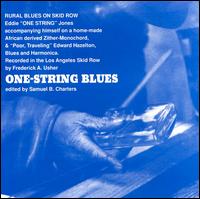Eddie "One String" Jones was a master of the diddley-bow, and had a driving, percussive playing style.
He beat out a rhythm with a wooden stick and used a half-pint whiskey bottle as a slide to change the pitch of the
string. Note that a full half-pint bottle of pancake syrup costs considerably less than a full half-pint
bottle of whiskey. As long as the bottle is made of glass (some syrup bottles are not) both are equally
effective. His playing style has been the starting place for the development of my own style, so I would
like to share some thoughts about his rhythmic playing and his use of the open string to maintain a tonal center.
If you strike the string of your diddley bow (you DID build one, didn't
you?) with a stick ON the beat in quarter notes (1, 2, 3, 4….) it sounds pretty boring. The sound
is only marginally improved by striking the string in eighth notes, accenting ON the beat, and striking less forcefully OFF
the beat (1 and 2 and 3 and 4 and…).
The rhythm is dramatically improved by damping (touching) the string lightly with your other hand as the less accented
"and" is struck, making a muffled ghost note (1 thump 2 thump 3
thump 4 thump …). This takes a while to master, but it is one of the keys to Jones'
style of accompaniment. He would sing while playing this way, and then play a melodic riff using the whiskey
bottle slide at the end of a line. Note that slight alterations of the timing of the damping change the
rhythmic feel, and changing the rhythm of the stick from a straight eighth note feel to a swing or shuffle feel opens up new
and interesting rhythmic horizons when coupled with damping. If you experiment with different rhythmic
feels using damping, your playing will go to a new level. While you are working on this, you might try
damping while holding the bottle slide. I use the sides of my little and ring fingers to damp the string
while holding the bottle slide with my thumb, index and middle fingers.
On his recording, Eddie Jones refers to his playing as one-string three-quarter banjo picking, and states that he makes
the string do two things. My current understanding of his approach is that he is using the open string
liberally in his playing, often alternating with notes played up the string with the bottle slide. In this
approach, the open string serves a purpose similar to the fifth string on a five-string banjo, establishing a tonal center
that repeats throughout the music, and serving as a reference tone for the pitches of the notes played with the bottle slide.
Thus, as Eddie Jones states, the string does two
things: open, it is a reference tone (such a reference tone is called a pedal tone by classical
musicians and a bourdon by ethnomusicologist Gerhard Kubik in his book Africa and the Blues (University
of Mississippi Press, 1999)), and noted with the slide, it serves up melodic riffs. With this in mind,
it is easy to see how Eddie Jones might consider this playing method to provide some fraction (let's not quibble about
"three-quarters") of a banjo sound.
Playing with a slide requires some practice to get the right "touch," and I find it difficult to describe how
to do this. The bottle needs to touch the string firmly enough to sound the notes clearly.
I tend to keep the bottle moving, especially in the positions equivalent to the 2nd to 3rd frets
on a guitar (the second note of a pentatonic scale). By thinking of this area as an expressive tonal range
to slide around in rather than a specific "note," your playing will get very bluesy. Be aware
that striking the string with the bottle held in the left hand causes the note to sound, giving an effect a guitarist would
call a "hammer-on."
In the paragraphs above, I have only scratched the surface of diddley bow playing. As I mentioned on
the home page, the available commercial recordings of traditional diddley bow players might fill two CDs, but would not fill
three, and each player that I have heard has a different approach. This indicates that there
are no rules, and there is plenty of opportunity to explore new playing techniques.
Anything that can make a different sound on one string is fair game, but the key is to integrate the new sounds into
your music. My approach has been to use traditional songs to try out new technical methods.
I hope you will take up the challenge and explore making your own music on this instrument!
